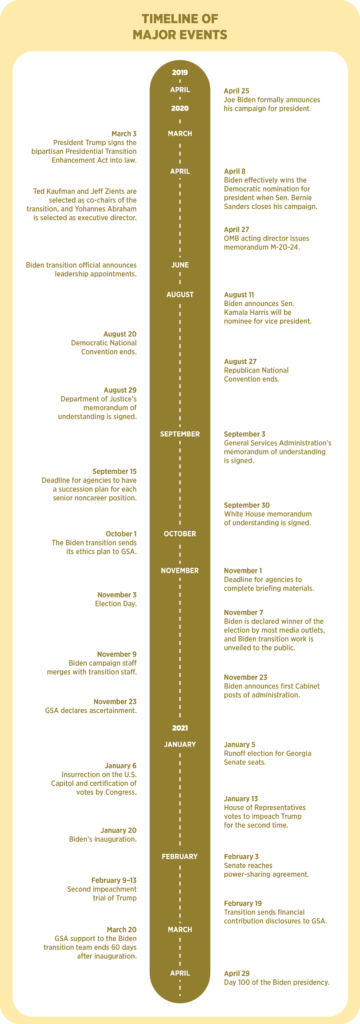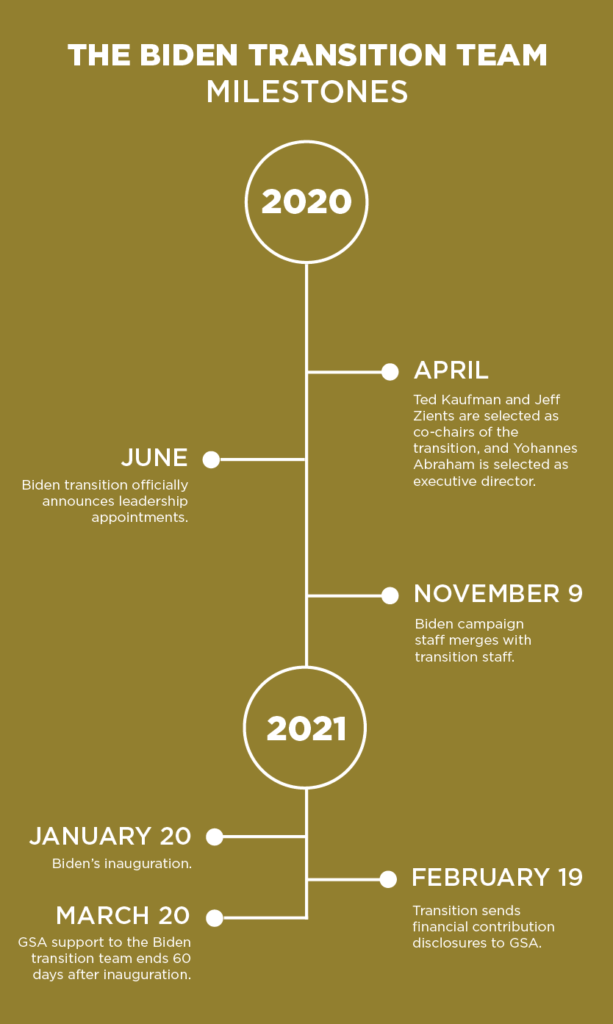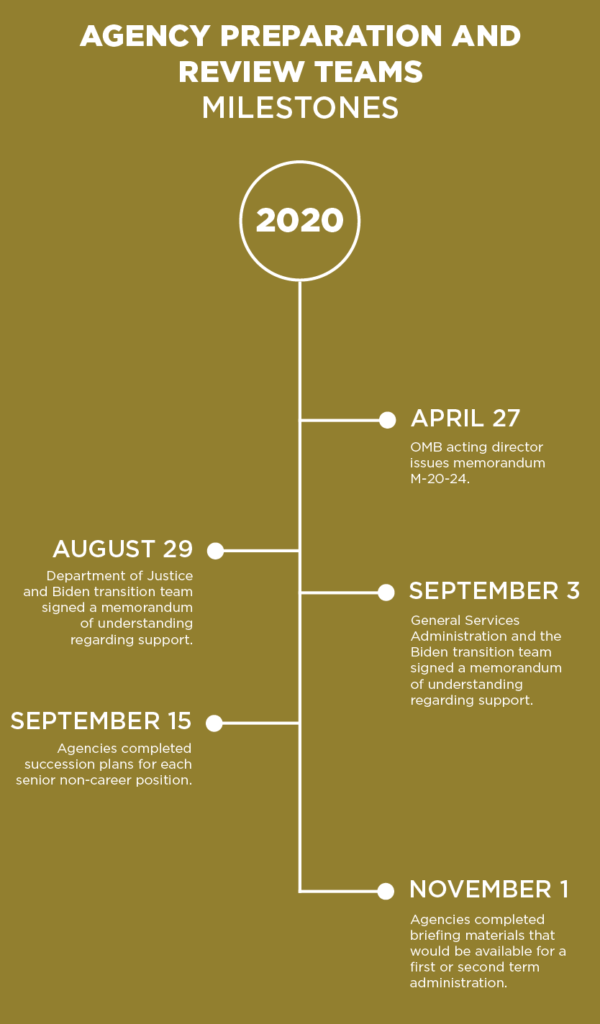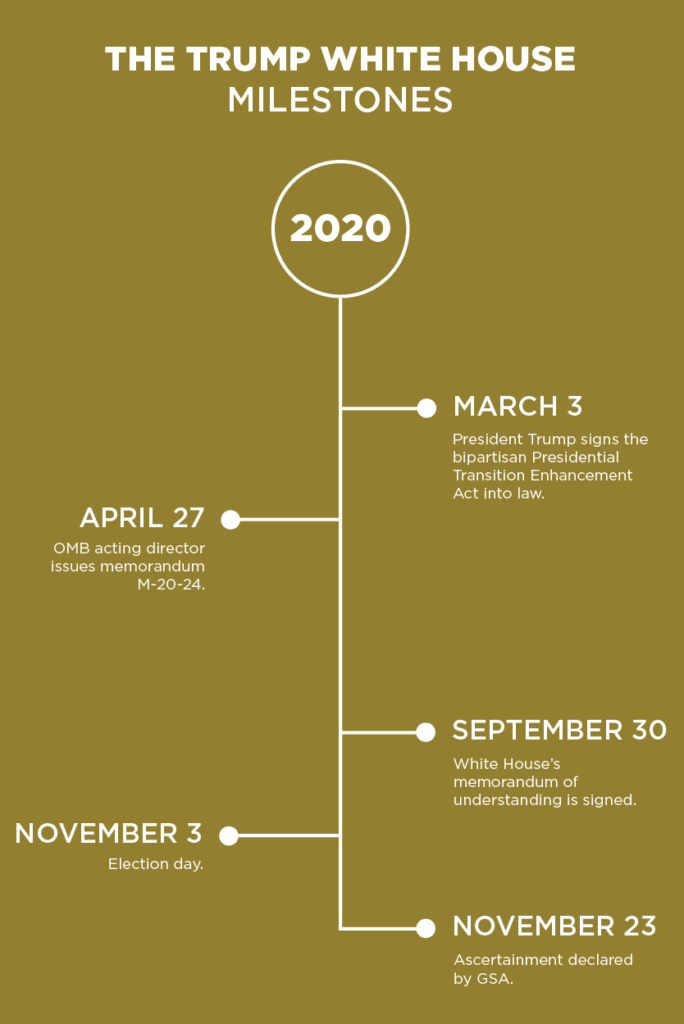

Executive Summary

Photo credit: White House/Joyce N. Boghosian
The transfer of presidential power is always a difficult process, but the 2020–21 transition from Donald Trump to Joe Biden was particularly arduous due to a combination of crises facing the country. This included the COVID-19 pandemic, an economic downturn, a nationwide reckoning on race, the outgoing president’s unwillingness to accept the election results and the Jan. 6 insurrection at the U.S. Capitol.
| The United States ultimately upheld its long tradition of the peaceful transfer of power on Jan. 20, 2021, and Biden began governing immediately with a substantial foundation of planning and personnel in place. This was in large measure due to months of preparation taken well in advance of the election, including contingency planning and the tireless efforts of many career agency executives, dedicated public servants within the Trump White House, and a Biden-Harris transition team that succeeded in building an impressive, well-resourced and organized transition
Nonetheless, the events of 2020–21 revealed longstanding areas of fragility in the presidential transition process. Trump’s refusal to concede the election led to a delay in ascertainment—the formal decision that initiates the government’s post-election financial and substantive support for the winning candidate. In addition to delaying funding and access to federal agencies, some members of the Trump administration were not fully cooperative with the incoming Biden team, further complicating matters. In previous transitions, some practices have been determined by law. Other major elements have been governed by norms and traditions. Sitting administrations helped a new administration prepare to take office regardless of party. While the Trump White House and federal agencies worked hard to meet the statutory transition planning requirements during the preelection period, Trump’s doubts about the integrity of the election and, in some instances, the lack of cooperation from his administration after the election exposed areas where norms and precedents were not enough to ensure a seamless transfer of power. |
Click to enlarge |
This report offers a detailed examination of the planning and execution of the 2020–21 presidential transition from the perspective of the Biden transition team, the incumbent administration and the federal agencies, with recommendations for future transitions.
Our findings reflect significant improvements to the presidential transition process created by a series of amendments to the federal transition law since 2010, and highlight areas requiring attention:
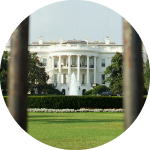
The role of an incumbent administration in a transition is as important as the work of the incoming team. Post-election events in 2020–21 demonstrated the potential for incumbent presidents seeking reelection to impede or fail to provide support for planning by their opponent. For future elections, Congress can reduce the potential for conflict and lost time by amending the Presidential Transition Act to ensure that a delay in ascertainment—for any reason—does not interrupt critical transition assistance for viable candidates, including post-election agency briefings.

The entire appointments process needs reform. Personnel vetting and disclosure requirements are increasingly complex, and delays in the Senate confirmation process grow with each transition. Although the Biden transition had a large and well-organized personnel team, which allowed for more than 1,000 nonconfirmed political appointees with a high degree of previous governing experience to be sworn in on Day One of the new administration, only about one-third of key national security positions requiring Senate confirmation were filled within seven months of Biden taking office. We describe in further detail options to streamline vetting and security processes and improve the Senate confirmation process.

The events of 2020 and other post-election issues that have occurred during the modern era underscore the need for contingency planning by transition teams to handle a wide range of unconventional challenges. In 2000, a close election shortened the transition period for George W. Bush; in 2016, key personnel changes to the Trump transition leadership after the election required a restart from scratch; and in 2020, the disputed outcome delayed the funding and access to the agencies after the election. The early decision by the Biden transition to devote time and resources to contingency planning helped the team deal with the unprecedented obstacles. The threats posed by cybersecurity risks, foreign actors and increased political polarization will only make contingency planning even more important in future years.

To reduce disruptions and better shift from the transition to governing, transition teams should create continuity in both personnel and policy planning. On personnel, transition teams should transfer the senior staff of their hiring teams to the Office of Presidential Personnel after the inauguration. On policy, transition teams should establish procedures that ensure materials created during the transition are shared with future officeholders.

The work of experienced career officials is the foundation for a successful transition. Many departments and agencies, including most notably the General Services Administration, benefited from selecting transition directors with extensive transition experience. These directors were crucial in helping the incoming administration be prepared to govern on Day One despite the delay in the ascertainment declaration.

By requiring virtual collaboration on an unprecedented scale, the remote work environment fostered by the COVID-19 pandemic presented real opportunities and significant challenges for the transition and agency teams. The 2020–21 transition was the first to be conducted almost entirely remotely. In hindsight, many government officials and transition staff felt remote options made meetings more efficient and allowed a wider range of people to participate in the process. At the same time, employing remote workers in many different locations created increased administrative burdens and collaboration challenges.

In addition to political leaders of all parties, the media, civil society and business leaders can contribute to the health of our country by supporting the peaceful transfer of power. All voices are important in communicating about, advocating for and defending transition planning and the transfer of power through a nonpartisan lens.
Since 2008, the Partnership for Public Service has served as the nation’s premier nonpartisan source of information and resources designed to help presidential candidates and their teams lay the groundwork for a new administration or for a president’s second term. Our 2010 “Ready to Govern” report on modern transition planning provided a roadmap to formalize and improve the culture, operations and resources of presidential transitions, and we have successfully advocated for a series of amendments to the 1963 transition law that have improved the process.1
During the past decade, perceptions that it is presumptuous to “measure the White House drapes” have given way to a general—but not universal—understanding that new presidents must plan ahead to provide leadership and continuity in a fast-paced and dangerous world.
Candidates have started transition planning during the first half of the election year as a matter of course. Following an election, presidents-elect now appreciate the importance of nominating their top national security and economic advisors, and the Senate has typically offered better-than-average attention to confirming these most senior positions soon after Inauguration Day while lagging behind on subsequent appointments.
The events of the 2020–21 transition, however, brought attention to longstanding areas of fragility and point to issues that require a stronger legal foundation, the need for increased financial support for a range of transition activities, improved agency planning and a focus on reforming the appointment process. Indeed, Biden transition team co-chair Jeff Zients said the Biden team’s goal was not only to prepare the best transition ever, but to do so in the hardest transition environment ever.
This report was produced by the Partnership for Public Service’s Center for Presidential Transition® and the Boston Consulting Group. Both organizations played crucial roles in assisting all three of the major stakeholder groups throughout the 2020–21 transition. A detailed summary of the Center’s work is available in the report entitled, “Looking Back: The Center for Presidential Transition’s Pivotal Role in the 2020–21 Trump to Biden Transfer of Power,” produced in April 2021.2
The Toughest Transition in History

Photo credit: Architect of the Capitol
Ever since George Washington handed the keys to John Adams, the peaceful transfer of power from one president to the next has been an American tradition. This critical aspect of our democracy, however, has often been quite challenging.
In 1861, Abraham Lincoln took office as southern states seceded from the Union. In 1933, Franklin Roosevelt became president during the Great Depression. And in 2009, Barack Obama became president during a major economic crisis. But none had the confluence of crises that faced the transition of 2020–21.
In the weeks following the 2020 election, filmmaker Ken Burns summarized3 the environment:
“We are in totally unprecedented territory … We are in a kind of perfect storm that in some ways outranks … the Second World War, the Great Depression and even the Civil War.”
“The inauguration occurred as prescribed by the Constitution, yet the circumstances were far from normal,” summarized the director of the White House Transition Project Martha Kumar. “With a nation scarred from the COVID-19 pandemic, a faltering economy and months of racial disturbances, followed by the insurrection at the Capitol, President Biden came into office with challenges few presidents have faced.”4
Challenges prior to the election
The largest public health crisis facing the country in 100 years began in January 2020 when the first confirmed case of COVID-19 appeared in the U.S.5 A lockdown followed in many parts of the country beginning in March 2020. By Biden’s inauguration in January 2021, the disease had killed more than 400,000 Americans.6 The pandemic and subsequent quarantine led to a global economic crisis as U.S. unemployment neared 15% and the global economy shrunk by an estimated 4.4%.7
In addition, the country was experiencing a racial reckoning following the May 25, 2020, death of George Floyd at the hands of a Minneapolis police officer. Along with a series of other police shootings of Black men and women, protests throughout the country brought the issues of race relations and police violence to the forefront.
The election occurred during a period when the country was experiencing historic levels of polarization.
A Pew Research Center survey in November 2020 showed almost nine in 10 registered voters who supported Biden or Trump worried a victory by the other candidate would lead to “lasting harm” to the country.8 The problem was exacerbated by the spread of misinformation on social media and other platforms, accelerating the spread of conspiracy theories that sowed mistrust and deepened divisions in the country.
While not identified at the time, the country faced additional overseas threats. In early 2020, Russian hackers launched one of the largest cyberattacks ever against the federal government and private companies. Later called the SolarWinds hack, the attacks went undetected for months and were not reported publicly until December 2020. The confidential data and communications of the government were breached, including at the departments of Homeland Security, State, Energy and Treasury.
Problems post-election
The events following the election, from Trump’s refusal to accept the election results to the storming of the Capitol, were likewise unprecedented. The decision known as ascertainment—the official recognition by the General Services Administration of an apparent successful candidate that allows a formal post-election transition to begin—did not occur until nearly three weeks after Election Day and about two weeks after most news organizations called Biden the winner.
A post-election transition period that was expected to be 78 days wound up being only 57 days.9 Even after ascertainment, the Trump White House and Biden transition differed in their views on the type of support an outgoing administration should provide.10 While the transfer of information was straightforward in many places, several agency officials were not fully cooperative.11 The Biden transition claimed they were not supplied with some crucial information related to national security, the budget, COVID-19 trends and vaccine preparation, and more.
The transition was further complicated by the violent insurrection on Jan. 6 against Congress as it met to officially certify Biden as the next president. The attack left about 140 police officers injured and one Capitol police officer dead.12 Four other officers died by suicide in the months following.13 One protester was shot and killed. When Congress reconvened that evening to certify Biden’s election, 147 Republican lawmakers voted to overturn Biden’s victory and made claims without any proof that the November election had been stolen from Trump. In the immediate aftermath of these events, some members of the Trump administration resigned in protest.
The control of the Senate was not decided until after the special election runoff in Georgia on Jan. 5, in which Democrats won the two races. Those victories created a 50-50 split and effectively gave Democrats control of the Senate because Vice President Kamala Harris would become a tiebreaking vote. Even though the 117th Congress was sworn in on Jan. 3, the Senate did not reach a power-sharing agreement until Feb. 3, which determined how committees and floor procedures would operate. Senate business cannot proceed in full without such an agreement, and the delay was one factor contributing to the slow pace of confirmations of some of Biden’s nominees for important government positions.
A week before Biden was sworn in, the House impeached Trump for inciting the Jan. 6 storming of the Capitol, the second impeachment of his presidency. The Senate trial was held from Feb. 9 to Feb. 13, during Biden’s first month in office, further delaying the confirmation of Biden appointees. The Senate voted 57-43 to convict Trump, falling 10 votes short of the two-thirds majority required by the Constitution to convict a president.
The country had experienced presidential transitions during other times of crises, but never had such a combination of problems come together quite like it did in 2020–21.
Improving the Transition Process

Photo credit: Shutterstock
| “Current transition teams need to look at prior transitions to learn how they were managed,” explained Gail Lovelace, a former General Services Administration official who served as the government’s director of presidential transition from 2007 to 2010. “Every transition is going to be different based on a variety of factors, including what is going on at the time in our country. Learn from the past, but really look for opportunities.”14
Both laws and norms guiding transitions have improved during the past 20 years. Looking back at how the process has changed can help inform how more improvements can be made in the future. One shift has been the perception surrounding transition planning. In 2008, Republican presidential nominee John McCain accused his opponent Barack Obama of “measuring the White House drapes” and was hesitant to engage in advance planning out of superstition.15 In 2010, the Partnership wrote, “Rather than viewing early, preelection transition planning as premature and presumptuous, our nation must recognize it as prudent and necessary, and acknowledge that failing to plan for the transition can leave the country vulnerable to issues ranging from national security to the stability of financial markets.”16 |
PRESIDENTIAL TRANSITION ACTPassed by Congress in 1963, the Presidential Transition Act was created to promote the orderly transfer of power from one administration to another. The law has been amended over the years to recognize the increasing complexities of transitions. The law requires the General Services Administration to provide office space and other core support services to presidents-elect and vice presidents-elect, as well as preelection space and support to major candidates. It also requires the White House and agencies to begin transition planning well before a presidential election, benefiting both first- and second-term administrations. Another benefit of the law is that it has offered political cover for career officials so they can fulfill the needs of a potential change in administration with minimal political interference. As has been done following recent presidential transitions, Congress should examine how the law might be updated to better address the challenges of modern transitions. This report offers multiple suggestions in the recommendations sections at the end of this document. |
Thanks to laws passed by Congress and public education efforts—especially the visibility of the thorough 2012 preelection preparations for Republican candidate Mitt Romney led by chairman Mike Leavitt—transition planning is now seen less as an act of overconfidence and more as an obligation for aspiring presidents to fulfill their constitutional obligations.
For much of the country’s history, presidential transitions have been informal processes. The transition process was formalized when Congress passed the Presidential Transition Act of 1963, which has been amended four times during the last two decades.
The law clarifies the assistance an incumbent administration must provide to eligible candidates even before the election. Sitting presidents, even if they are running for reelection, must create a White House Transition Coordinating Council as well as an Agency Transition Directors Council composed of career officials. The GSA administrator must designate a senior GSA career executive to serve as the federal transition coordinator. The law has been both a guide for presidential transitions and offered political cover for career officials so they can fulfill the needs of a potential change in administration without too much political interference. The law also requires GSA to provide office space and support to eligible candidates immediately after the national political conventions.
Recent history shows that advances in the presidential transition process can happen. The transition of 2020-21 illustrated several other areas where more improvements are necessary.
The Biden Transition Team

Photo credit: Shutterstock
| Candidate Joe Biden and his transition chairs decided the key to a successful process would require a large, experienced team that improved on processes of the past and produced innovative ways to design policy. The ongoing crises the new president would face meant there was not much space for people to learn on the job.
To match the breadth of problems facing the country, the Biden transition leadership subscribed to many best practices used by previous transitions, made early decisions about how their organization would run and made some innovative choices that allowed for the successful transfer of power despite many unforeseen obstacles. |
Click to enlarge |
Preelection: Transition planning begins
March–November 2020
The Biden transition team—which later became the Biden-Harris transition team—began initial transition planning in March of 2020, about eight months before the election and 10 months before a potential inauguration—roughly the same timeframe some of the most recent presidential hopefuls began planning.
From the outset, the goal of the transition was to prepare an administration that would be able to act on the policies and promises made by the candidate. By drawing on his vast experience, Kaufman created four guidelines the transition followed throughout and became the foundation of the effort.
- The transition does nothing to hinder the campaign.
- What happens during the transition stays with the transition.
- Policies are made by the campaign, not by the preelection transition team.
- Staff for the transition and agency review teams should mirror the demographics of the country.
Among Kaufman’s first acts was to assemble a team to select transition leaders, including people who worked on President Barack Obama’s 2008 transition and advisors Biden had known for years. The group decided former National Economic Council director Jeff Zients would be the best person to oversee the transition. “We wanted somebody with lots of successful experience—not experienced in transitions, just experience in management—who was highly organized and totally discreet,” Kaufman explained.18 Zients recommended Harvard Kennedy School of Government lecturer Yohannes Abraham to be executive director and run the day-to-day operations. Abraham, like Zients, was known as a disciplined manager. Having taught a class on presidential transitions at the Kennedy School and served in senior roles in the government, private and nonprofit sectors, Abraham brought a wealth of experience to his position as the Biden team’s leader and organizer.
By that point, most of the country was already in a lockdown with stay-at-home orders due to the COVID-19 pandemic. “We had no idea how long [the pandemic] would last … We realized we needed to plan for a virtual transition, which would increase the degree of difficulty considerably,” Kaufman said.19
Many of the transition staff would later agree that having a virtual transition was, in some ways, more efficient and inclusive than an in-person effort. People living outside of the Washington, D.C., area could participate more easily, and staff members did not have to take time between meetings to relocate. Nonetheless, the early and ongoing challenges presented by the remote work environment–from maintaining security to building a cohesive team culture–required constant effort to overcome.
The transition team followed the public health guidelines related to the ongoing COVID-19 pandemic. As with the Biden campaign, in-person transition events were intentionally limited in size and frequency. Transition staff members worked almost exclusively from home throughout the entire process. After the election, a few members of the transition team went to in-person meetings to access classified information.20
The transition officially announced the appointments of Kaufman, Zients and Abraham in June.21
Learning from previous transitions
The Biden leadership studied past transitions and uncovered several problems that had plagued those efforts. They also knew the unprecedented pandemic required innovative approaches. The transition team made several key choices that would allow them to successfully complete transition planning even during the most trying of circumstances.
Connecting transition planning with the campaign
A natural tension exists between the transition and the campaign staff. Both represent distinct teams vying for personnel, influence, and the candidate’s time and attention. Kaufman anticipated such challenges, which led to his first rule that the transition must not hinder the campaign in any way. This shaped the entire transition.
Staffing and the transition as an employer
Most organizations do not start with a small team and ramp up to a staff of thousands in the span of a few months. The Biden transition knew the creation of such an organization required innovation and room to grow. Building a culture and infrastructure that could be scaled quickly was a top priority. This meant the team needed to create clear rules on issues such as pay, health care and onboarding practices that were communicated clearly and consistently to everyone involved.
When discussing the staffing plan and how they built their culture, Abraham mentioned the importance of finding people who matched the ideals of the candidate and leadership. “We only looked at people who … really shared a sense of passion about this moment in time,” Abraham said. “Everyone we brought onto [our] teams, really at a gut level, internalized their responsibility to their colleagues on the campaign side, their responsibility to keep things quiet, to keep things to themselves and to not do anything that could in any way distract from the goings-on of the campaign.”23
This unintentionally precluded some qualified individuals from participating because they could not afford to take a leave of absence from their jobs. Some volunteers who wanted to devote a significant amount of time to the transition depended, in part, on the goodwill of employers to make it possible by allowing them to keep benefits such as health insurance while on leave.
Furthermore, ethics and conflict of interest policies applied by the transition prevented some skilled people from getting involved, especially from the technology community. Policy leaders on the transition—including DJ Patil, the country’s former chief data scientist—stated that many people could not afford to join the transition for little or no pay. They also highlighted that the structure of conflict of interest rules for the federal government were too broad which discouraged some qualified people with technical backgrounds to join the transition.
Despite the difficulties, the transition team’s leadership adopted stringent ethics requirements to signal the incoming administration’s commitment to increasing public trust in the federal government and those who serve.
Emphasizing the importance of IT security
Technology security was a top priority for the Biden transition in part because of the new threats of ransomware as well as hacking from external actors, which occurred during the 2016 election. Hackers were not just interested in stealing official information, but were also interested in personal emails and correspondence.
Integrating the transition IT systems, which were started in April, with systems used by government agencies, was a challenge. The transition team set up a comprehensive IT system months before Biden officially became the Democratic nominee. By the time the political party conventions ended and GSA was able to provide IT services, the Biden transition team had its own infrastructure in place. Even after the Biden team received access to GSA systems, the ascertainment delay created an additional set of timing concerns that complicated the process.
Creating integrated transition policy teams
Another innovation was the creation of a team focused on technology policy and implementation led by Patil and Jennifer Anastasoff, a founding member of the U.S. Digital Service. Some previous transitions grouped the challenging work of forming technology policy with their internal IT teams. The Biden transition divided those two critical functions. The team knew that the successful implementation of many policies, such as the ongoing Paycheck Protection Program passed by Congress, would be dependent on first-rate planning.
Preparing to fill as many political appointments as possible on Day One
New administrations must make about 4,000 political appointments, roughly 1,200 of which require Senate confirmation. Because the Biden transition officials were focused on confronting the challenges facing the country as soon as they took office, they sought to get more of the roughly 2,800 nonconfirmed appointees in place on the first day in office than any other administration had in their first 100 days.
| “That was basically born of our observation that we had to hit the ground running early after Inauguration Day,” Abraham said. “We wanted to make sure that our senior Cabinet officials, upon confirmation, had appropriate and adequate support … And we wanted to make sure that given the degraded capacity of some agencies … we knew that argued for having more slots filled earlier in that first term than prior transitions had invested in.”25
According to the transition, a record number of 1,136 political appointments were made on Biden’s first day in office, and about 1,500 by the 100th day.26 |
Increasing diversity in government was one of Kaufman’s four primary rules and a clear objective of the president-elect. This meant factoring in elements such as gender and geography along with racial and ethnic diversity. The transition also prioritized including representation of first-generation college graduates, first-generation Americans and disabled people.
For example, the Office of Presidential Personnel noted social media accounts complicated the vetting process during transition and after the inauguration. In addition to the process of reviewing each nominee’s taxes and employment history, the Biden White House deployed about three dozen people to review the social media history of new appointees.29
Some ethics requirements also serve to rule out otherwise qualified individuals and can play a role in hindering diversity. For example, rules on stock ownership “were written for people on Wall Street, but do not apply for people working in tech startups,” one transition advisor said. Many people involved with technology company startups receive stock as a major part of their compensation package, and having to divest those stocks is a financial challenge. Others suggested that rules regarding marijuana usage should also be revisited in the wake of changes to many state laws.
Well-intentioned ethics rules and vetting requirements have expanded so much in recent years that the process is occasionally in danger of becoming inaccessible for all but the most advantaged appointees.
The involvement of multiple overlapping forms and agencies in vetting and appointments, combined with a lack of transparency, has left appointees without a clear picture of where they stand in the process at any given time, and when they can expect to move forward. This lack of clarity prevents appointees from planning with their families and employers, and agencies from knowing when their leaders will come aboard.
A tool that tracks and displays the status of appointees in real time—and consolidates data requests—would reduce the uncertainty that clouds the appointment process, make public service more appealing for those outside government and enable better decision-making by appointees, agencies and the White House. The White House would have to champion a project that would require participation of multiple agencies. This tool would be useful for the Office of Presidential Personnel going forward and should be made available to transition teams to smooth the path for initial appointments.
Creative and risk-conscious contingency planning
Early in their planning, Biden transition leaders created a specific workstream they referred to as “unconventional challenges.” Not only would a new administration be confronting a pandemic and an economic crisis, but they felt it was important to prepare for unforeseen or unpredictable obstacles. To transition leader Kaufman, planning for risks was an obvious decision. “It’s management 101,” he said. “Any business school would tell you to plan for risks.” The team made a list of 70 potential problems before they stopped counting. At first, the team divided the challenges into three categories: challenges to the integrity of the election and validity of the results, challenges to the economy and challenges to effective governance.30
In retrospect, the contingency planning wound up being among the most critical decisions the transition team made. “I don’t know what probability … I or others would have assigned to the possibility that ascertainment would be delayed,” Abraham recounted. “But it was not a zero. And the fact that it was nonzero and it was appreciable meant that we had to have a plan for it.”31
Abraham added, “The agency review teams led by Cecilia [Muñoz] built a whole suite of programming that the agency review teams could do in the scenario where … it was post-election and that we were not ascertained, and we did not have access to the federal agencies.”32
Led in part by the transition’s general counsel, the contingency planning focused on the memos of understanding signed by the transition and considered what problems could arise in the case of a delayed ascertainment or other unpredictable events. The planning discussions determined that the most critical potential problems involved access to funding, technology and information from agencies.
To prepare for these potential problems, the team raised additional money before the election to ensure there would be adequate cash on hand if federal funding was curtailed. The team set up a comprehensive technology platform using software that could function independently of federal services. And in lieu of contacts with agencies immediately after the election, agency review teams created detailed plans to consult with former political and career officials, policy and operations experts who possessed knowledge of what was happening inside federal agencies. Talking to former officials is not as informative as speaking with current staff. But this decision allowed the agency review teams to begin their substantive inquiries as they waited for ascertainment.
Transition policy work going unused
The Biden transition was aware that in the past, some of the transition policy work went unused or unshared once the new administration took office, which affected the shift from the transition to governing. And although the Biden transition tried to mitigate this problem, it encountered similar issues.
Members of the Biden transition policy teams expressed concern that significant portions of the planning work conducted prior to the inauguration were not received by White House officials or agency leaders once they were in office. This gap required new officials to start from scratch or simply not reflect the hard work of the transition period, wasting months of innovative thought leadership and analysis.
There is no single reason for this communication breakdown. Some of the work was pre-decisional or exploratory, some was sensitive, some was likely protected due to public records requirements at agencies, and some was simply lost.
Future policy teams should establish methods to better share materials created during the transition with officials who take office, being conscious of potential barriers and designing their processes with this in mind. If content is meant to transfer to agencies, policy leads should be aware of future Freedom of Information Act or presidential record requirements up front rather than discard work at the end of the transition due to last-minute risk aversion. They also should work with appropriate counsel to understand what this may entail.
Structure of the Biden transition team
When creating the transition team’s structure, the leaders wanted to improve on previous efforts by breaking down silos and making the vetting and hiring processes more efficient. They also knew the organization needed to be agile and technologically savvy.
The Biden transition team considered May through August their “prep period” where they identified leadership, set up infrastructure and determined how the organization would function. They also created the groundwork for how policy planning for a potential Biden administration would be developed.
The team started small. However, by the time the Biden transition team was in full gear, it had about 1,500 staff and volunteers.33 The transition was led by five co-chairs including Jeff Zients, Anita Dunn, Ted Kaufman, New Mexico Gov. Michelle Lujan Grisham and Cedric Richmond, then a congressman and co-chair of the 2020 Biden presidential campaign. Executive director Abraham oversaw 13 departments.
Post-election: getting ready for Day One
November 2020 – January 2021
Once the election is finished and a winner is declared, transition planning kicks into another gear. The transition team can begin to have contact with federal agencies and receive financial and operational support from the General Services Administration. The 2020 transition was hindered by the delay in ascertainment and the refusal of the sitting president to acknowledge that a transition would occur. But the Biden transition team found ways to work around such obstacles, thanks in part to their prior contingency planning.
Ascertainment delay
The ascertainment delay was unprecedented and placed a burden of stress and complexity on the public, the Biden transition team and federal agencies. For the Biden team, it presented financial, relational and coordination delays. Some of these harms were mitigated by implementing a backup plan based on their early contingency planning.
With this foresight, and due to the mission-specific focus of transition staff and volunteers, the impact of ascertainment did not monopolize the concerns of most transition staff.
“The focus for [Biden] was standing up the incoming government, and that’s what all of us were focused on,” said Cameron French of the communications department. “I think [Biden’s] comments were limited [on external events] because we had a list of 25 things to do every day, and maybe No. 25 was worrying about the ascertainment decision.”
Still, the very practical effects of the delay were real and preventable, meriting attention from Congress and from future White House and transition team planners.
Jan. 6 attack
On the day of the Jan 6. attack on the Capitol, Biden described the events as “an assault on the citadel of liberty” and blamed President Trump for stoking the mob.35 But members of the Biden team said the reverberations from the attack did not require much change in their strategy or timeline.
“To some extent, we were like every other American watching it unfold, but were not able to intervene. There was a sitting government in place that was responsible for that,” French said.
Planning to deal with the COVID-19 pandemic
Consistent with Biden’s focus on the COVID-19 pandemic during the campaign, the transition prepared extensively to combat the virus once assuming office.
One of Biden’s first major post-election actions was to establish a COVID-19 advisory board, which included three prominent co-chairs: Marcella Nunez-Smith, a Yale physician and researcher; Vivek Murthy, a former U.S. surgeon general; and David Kessler, a former Food and Drug Administration commissioner.
Biden announced Ron Klain would be his chief of staff. Klain worked with the transition on its COVID-19 plan and was part of the Obama White House team that combated the 2014 Ebola outbreak. Klain told Politico that Biden’s view was “that information should come from medical experts so it would be seen as neutral, expert-based advice and not shaped by political considerations.”36
Other priorities were to ensure hospitals had necessary protective gear and to build a public communication campaign combatting vaccine hesitancy. “We are fully eyes-open that there needs to be a rebuilt trust in government and institutions and what is communicated to the American people, and that’s part of the discussion,” said Jen Psaki, who would later become the White House press secretary.37
In early December, Biden named several officials to lead the nation’s public health functions. He tapped Zients, his transition co-chair, to serve as the White House COVID-19 coordinator; California attorney general Xavier Becerra to lead the Department of Health and Human Services; and Dr. Rochelle Walensky, chief of infectious diseases at Massachusetts General Hospital, as the director of the Centers for Disease Control and Prevention. In addition, Biden named Dr. Anthony Fauci of the National Institutes of Health as chief medical advisor on COVID-19.
In January, Biden announced his $1.9 trillion COVID-19 relief plan known as the American Rescue Plan. To develop the plan, the transition team worked to gain access to the Trump administration’s data before and after ascertainment. Murthy said the transition team sought real-time data on metrics such as hospital bed capacity, medications in government stockpiles and vaccine distribution plans.38
The Trump administration allowed transition officials to attend the coronavirus task force meetings beginning on Jan. 11. The transition team gained access to Tiberius, the government’s vaccine distribution tracking software, in mid-January.39 While participation in these meetings and access to the system demonstrate cooperation on the Trump team’s part, both came later than the Biden team requested.40
Agency review teams
Agency review teams are responsible for collecting information about the roles and activities of each major department and agency of the federal government, and for providing insights that will be useful to the new administration as it assumes power and pursues its policy agenda.
The nearly three-week delay in the declaration of ascertainment proved especially challenging for the agency review teams. They were unable to have contact with career agency employees. However, the transition created a contingency plan for such a scenario and began interviewing hundreds of former career and appointed officials from each agency, as well as experts in think tanks, nonprofit organizations and academia. The review teams also stepped up their research efforts on publicly available information. While these efforts could not replace engagements with current federal officials, the effort helped minimize the negative impacts of the delay.
| The Biden agency review effort differed from previous transitions in two more significant ways. First, team members were selected not just for their knowledge of policy, but also for their ability to help execute policy. The teams included budget and legal advisors along with technologists who examined how technology could be used to administer programs. The organization of a nationwide vaccine distribution plan, for example, would involve technical capabilities and planning. Learning from examples such as the problematic launch of HealthCare.gov in 2013, the transition emphasized implementation and technical knowledge.
Second, the Biden transition placed a large emphasis on engaging career civil servants. The transition hired many former agency leaders and former civil servants who had longstanding relationships with career executives. Research by the Center found that nearly 76% of agency review team members previously served in government. Agency review team leaders stressed the importance of treating the civil service with respect and admiration, and incorporated these themes into onboarding and training sessions. Another priority for the transition was to include many prospective appointees on the agency review teams. Muñoz studied previous transitions and determined there needed to be effective strategies for getting information to incoming officials. |
AGENCY REVIEW TEAMS
|
“We tried hard to recruit people, both for the agency review teams as well as for the policy teams … who fit the profile of folks that would be likely to land in those jobs,” Muñoz said. “We set a goal of trying to convert more agency review team members into government officials than previous transitions.”
Integrating campaign and transition teams
An issue that plagued previous election winners has been the integration of campaigns and transition staff, who often competed for jobs in a new administration. The Biden transition planned accordingly. While members of the transition policy teams are often well-prepared to get a White House job based on their transition experience, many members of the campaign staff are also hopeful of landing such a job, which can cause tensions between the two organizations. Part of the transition team’s mitigation strategy was to reserve jobs specifically for campaign staff.
“We knew from previous transitions that moving from the campaign to the transition was uniformly a pretty uncomfortable experience,” Muñoz recalled. “We understood that a relatively small number of campaign staff were going to move over to the transition [after the election], but we tried to make sure that they had clear roles we identified with the campaign leadership in advance so they felt some sense of connection. We had specific spots reserved on the agency review teams since the agency review work ramps up right after the election.”
Integration takes place as well between the transition team and the emerging administration. Transition officials must adapt quickly as some team members are selected for positions in the administration. This involves a balancing act between incorporating new leaders, executing transition responsibilities and preparing for permanent positions. After the selection of Ron Klain as White House chief of staff, for example, he coordinated with transition leaders and assumed a more public role in speaking for the incoming administration.
Post-inauguration: transitioning to governing
Work on a presidential transition does not conclude when a new president is sworn in. While the Biden transition organization worked to shut down operations in accordance with relevant laws, some of the policy and personnel planning conducted during the official transition carried over to the first few months of the new administration.
Winding down the transition organization
Since the offboarding for a large staff would take time and resources, the Biden team began this process around Dec. 15, 2020. This included staff returning laptops and turning off access to email and other systems. On a few occasions, work was dropped prematurely, necessitating a process to “re-onboard” people. Full-time employees who were not getting a job in the administration had their health insurance covered until Feb. 1.
Sixty days after the inauguration, March 20, GSA support for the transition team ended while 18 people remained on the transition team to complete its work. Six months after the election, only a small number of people still remained working for the transition organization to handle outstanding requests and complete tax requirements.
Early executive orders and legislation for the new administration
The Biden transition identified executive orders as a critical tool to address key policy goals and signal they were moving quickly to address the country’s problems. These executive orders were written during the transition period so they would be ready to issue soon after taking office. Biden signed nine executive orders during his first day in office and 19 by the end of his third day.41 By contrast, Trump signed just one during his first three days, Obama signed five and George W. Bush did not sign any executive orders.
Biden’s executive orders included direction on preventing discrimination and advancing racial equity in the federal government’s services, programs and procurement, and several related to the ongoing COVID-19 crisis. Biden invoked the Defense Production Act to bolster vaccine production and increase the availability of personal protective equipment.
In addition to planning for executive orders, future transition teams should assure their personnel teams prioritize appointees who can implement those initiatives quickly and effectively. Without such skilled appointees in place, the implementation of executive orders becomes more difficult.
Two major pieces of legislation that had been part of Biden’s campaign promises were proposed to Congress on Inauguration Day. The first was the $1.9 trillion American Rescue Plan, also known as the COVID-19 relief package. The second was the U.S. Citizenship Act of 2021, which aimed to create a roadmap to citizenship for undocumented individuals and create a permanent solution for recipients of the Deferred Action for Childhood Arrivals program.
The Biden administration credited its policy work during the transition along with outreach to Capitol Hill prior to Biden taking office for the early legislative action.
Slow pace of Senate confirmations
The substantial number of presidential appointments requiring Senate confirmation—about 1,200—has been an obstacle for all recent administrations to get their staff in place quickly. A reduction of the number of such positions would speed up the overall confirmation process and decrease the length of vacancies in essential positions. As the late editor of The Washington Post’s editorial page Fred Hiatt wrote, “It’s difficult to put meat on the bones of any agenda without ambassadors, assistant secretaries of state and defense for different regions in the world.”42
The Senate should also review and streamline its confirmation process, including fixing the privileged nominations calendar to make the confirmation of noncontroversial nominees simpler and faster.
Even though Biden announced more nominees for presidential appointments than previous presidents, the pace of confirmations by the Senate was still slow after he assumed office. For example, Biden announced all 15 of the primary Cabinet positions by Jan. 7—about two weeks prior to his inauguration. However, 15 days into Biden’s presidency, the Senate had confirmed only five Cabinet secretary nominees. At a comparable time, President Bill Clinton had 13 nominees confirmed, George W. Bush had 14, Barack Obama had 11 and Donald Trump had four.43
All recent presidents have faced challenges getting confirmations through the Senate, and the Biden administration suffered a similar problem even though it submitted more nominees than recent presidents. By the 100th day in office, Biden had submitted 220 nominations to the Senate, 30 more than Obama and 130 more than each of Trump and Bush. However, only 44 of those submissions had been confirmed, far fewer than the 67 confirmed for Obama.
Not only do new administrations have to get officials confirmed to leadership positions, but they must prepare those officials to do the jobs. Congressional appropriations for the 2020 transition provided GSA with $1 million for orientation activities for new Biden administration appointees. Orientation activities for new appointees—whether experienced government veterans or new public servants—can be incredibly valuable to incoming leaders as a means to set common assumptions and values, level-set on new or challenging dynamics, and increase awareness of specific substantive issues. These orientations present a unique opportunity to train incoming appointees, and agencies should consider offering orientation sessions as part of their onboarding process.
Budget delay
New presidents are required by law to submit their budget proposal by the first Monday in February. Preparing to revise and submit a federal budget is a crucial part of transition policy planning and is one of the most significant opportunities to demonstrate priorities for a new administration. The Biden administration did not release its budget until May 28, well after the statutory deadline. However, this delay is not uncommon. Trump released his first budget in mid-March while the previous three incoming presidents did not meet the deadline either and released theirs in April or May. Each of those, however, advised Congress regarding the general overview of their policies in a message submitted to Congress in February.44
The Biden administration claimed one main reason for the late release was lack of cooperation from the outgoing Trump administration’s Office of Management and Budget.
“The previous administration’s political appointees at OMB placed severe limits on the type of assistance career professionals could provide the Biden transition team, including blocking analytical work that is necessary to developing a budget,” OMB spokesperson Rob Friedlander told Roll Call.45 Transition executive director Yohannes Abraham suggested the lack of cooperation would complicate COVID-19 plans for the incoming president.46
Contrary to past practice, the Trump White House did not believe it had an obligation to help the incoming Biden team on the budget during the transition. “OMB staff are working on this Administration’s policies and will do so until this Administration's final day in office,” Trump OMB director Russell Vought wrote. “Redirecting staff and resources to draft your team’s budget proposals is not an OMB transition responsibility.”47 OMB’s sparse provision of resources and lack of analytical support did more than just inhibit the Biden team’s development of a budget. It also hindered government-wide planning for regulations and rulemaking. As Martha Coven, the OMB agency review team lead, explained, “OMB is so crucial to everything that government does that blocking our team there effectively blocked our team elsewhere too.”
Agency Preparation and Review Teams

Photo credit: Department of Agriculture/Bob Nichols
In 2020, despite major crises facing the country and the controversies that surrounded the aftermath of the election, most federal agencies followed the applicable laws and handled their roles with professionalism.
Preelection: Transition planning begins
Early 2020–November 2020
A career civil servant with more than 40 years of federal service and deep knowledge of presidential transitions, Gibert was picked because she was “experienced, honest, straightforward, transparent and knew how to do it right,” according to former Deputy GSA administrator Allison Brigati.”48
Career executives found the statutory requirements of the Presidential Transition Act, along with external communications, helpful in creating space for them to begin their work. Paula Molloy, transition lead for the U.S. International Development Finance Corporation, said, “What really helped prompt us [to start with transition planning] were the GSA communications and the Partnership for Public Service’s Center for Presidential Transition’s communications. That actually helped me work with leadership and say, ‘We must appoint someone responsible for this and we need to ensure we successfully complete each project assignment.’”
Agency transition planning gets underway
According to Gibert, GSA began planning for a potential transition at least two years before the election.49 The staff wanted to make sure they were prepared to support other federal agencies when those agencies started their own planning.
The preparations that GSA and others must make in advance of an election are extensive. GSA works closely with several agencies—the Office of Government Ethics, Office of Personnel Management, National Archives and Records Administration, and Department of Justice—that are informally known as the service providers because they support preparations government-wide for a presidential transition.
- OGE trains executive branch agency ethics officers, issues guidance to outgoing administration appointees and reviews ethics forms from prospective nominees.
- OPM creates transition guides for agency HR professionals and compiles information for the Plum Book on presidential appointments.
- NARA works closely with agency records officials and the White House to preserve all necessary records.
- DOJ must work closely with transition teams and the Federal Bureau of Investigation to process hundreds of clearances for transition team members before and after the election. DOJ typically signs two memoranda of understanding with transition teams: one after the party nominating conventions and then a second after the election.
The service providers must make these preparations without compromising their core responsibilities, which presents significant resource challenges and tradeoffs. Past transitions have appreciated the dedication of these agencies, but also experienced frustrations in the limits on capacity of these service providers.
To strengthen the service provider agencies, Congress should take several steps. First, Congress should consider additional appropriations to support a surge of personnel and resources for service provider agencies that experience increased workloads during transition years. Second, GSA would benefit from appropriations that are dedicated to its own transition needs in addition to appropriations that are given for the purpose of disbursement to transition teams. Finally, Congress should reinforce OMB’s role as a service provider to transition teams. Given OMB’s central responsibility for regulations and rulemaking across all departments and agencies, treating OMB as a service provider similar to OGE, FBI and NARA would help incoming teams develop their agendas.
The service provider agencies themselves may also consider ways to improve future transitions. One step that DOJ may consider, for example, is consolidating its memoranda of understanding with transition teams, following GSA’s example. Early in the transition process, GSA signs one MOU with each transition team that accounts for both preelection and post-election planning. Having a single agreement would expedite post-election cooperation, particularly if an ascertainment delay occurs.
Some agencies began planning for transition early in 2020. At the Department of Homeland Security, for example, Mark Koumans was appointed transition coordinator and started assembling a team and examining previous transitions as early as February. Agency transition efforts formally began on April 27 when acting OMB director Russell Vought issued memorandum M-20-24. This memo instructed the heads of executive departments and agencies to designate a senior career executive as the agency transition director by May 1.
In smaller agencies, an experienced senior career executive generally worked with a small team of two to four people. Agencies with effective transition efforts provided timely communications to keep their colleagues informed. Since much agency work is based on precedent, agencies should clearly document all the steps and procedures they use each cycle.
The agency transition directors selected for 2020 were a seasoned group. According to an analysis by the Center, about half of ATDC members worked on transition planning in 2016 while about one-third served in the same role. These transition veterans were deliberate in thinking of how best to support a first- or second-term administration.
Convening transition leaders from various agencies
There were two primary forums for agency transition leaders to convene and share information: the Agency Transition Directors Council and the Agency Transition Roundtable. Both forums met monthly and provided opportunities for agency transition directors to build relationships with their counterparts, exchange ideas, share best practices and hear from experts.
The ATDC was created by the Presidential Transition Act and is co-chaired by GSA’s federal transition coordinator and the OMB’s deputy director for management. The council includes agency senior career officials responsible for transition activities. It is required to meet at least once a year in non-presidential-election years. During presidential election years, the council meets on a regular basis starting six months before the election. In 2020, the ATDC was chaired by GSA and OMB. It consisted of representatives from 15 Cabinet departments and six other agencies, and began monthly meetings in May. During these meetings, agency transition directors discussed the state of preparations and guidance from the White House. They also conferred with former agency transition directors on best practices for transition planning and meeting requirements. The members and topics covered by the ATDC during each presidential election provide a unique opportunity to connect experienced officials throughout government with agencies that require specialized help on certain transition issues.
The ATR meetings were led by two groups outside the government: the Partnership for Public Service’s Center for Presidential Transition and the Boston Consulting Group. The ATR met six times between June and Election Day, coordinating topics and questions with GSA. Each meeting was attended by more than 100 senior career executives from 65 agencies. Many officials stated they found immense value in the ATR meetings, especially the opportunities to hear from former agency transition directors and presidential transition team members. The Transportation Department’s transition director Keith Washington reported the meetings created helpful opportunities for “small groups where people were able to meet each other and to tap into networks.”
Although there were similarities, the ATR was able to provide opportunities the government-led ATDC meetings could not. ATR meetings were open to a larger group of agencies and people beyond the agency transition directors. ATR meetings explored how agencies could meet core transition objectives and fulfill the guidance they received from the ATDC and GSA. The experience with ATR shows an area of opportunity for future ATDC meetings that could be used to review lessons learned from previous transitions and identify possible future improvements.
Agency deliverables
Under the Presidential Transition Act, agencies are required to produce two categories of deliverables:
- Succession plans for each senior noncareer position by Sept. 15 of an election year.
- Briefing materials for new appointees by Nov. 1 of an election year.
The succession plan requirement was slightly different in 2020 than it was in 2016. Previously, the Presidential Transition Act required the head of the agency to designate a career employee to serve in an acting capacity for every noncareer position they deemed “critical” if that position were to become vacant. Legislation signed into law in 2020 required agencies have succession plans for each “senior” noncareer position.50 In both cases, agency transition directors were often unsure about which positions required succession plans. Agencies made decisions by drawing on past precedent, consulting with general counsels and asking other agencies like their own. GSA reported that almost every agency completed its succession plan by the scheduled deadline of Sept. 15.
Agencies should share their succession plans with transition teams. Considering that acting officials often remain in place for months, agencies should support these future acting officials with training, resources and support necessary for them to conduct the full scope of their responsibilities.
As Molloy of the U.S. International Development Finance Corporation explained, “Being forced into an electronic process made things more efficient. [After] going through 2016, 2012 and 2008, I was used to really big binders. It was really nice to know that your final deliverables were actually the electronic documents. Once you did that … you were done, and you didn’t need a huge conference room for putting binders together.”
Scott de la Vega, the agency transition director for the Department of the Interior, added, “We made [an online] site that was secure, password protected and somewhat interactive … I was able to press a button and share the access to the entire set of materials. It took a lot of work by our IT folks … but I highly recommend that in future transitions … we continue to do that.”
Some agencies found creative ways to share information with the landing teams, the transition team representatives who interact with agency officials following the ascertainment decision. The Department of Homeland Security, for example, placed briefing materials onto specially designed iPads that were sent to members of the Biden transition team to ensure security and prevent IT complications.
Working remotely
Prior to the election, the ever-changing COVID-19 situation created a need to plan for both remote and in-person work arrangements. This added a new layer of complexity to communications between agencies.
One challenge was that the government does not share a single IT platform across all agencies. This issue impacts the federal government even beyond transitions. But the incompatibility of video conferencing, file sharing and other collaborative software proved especially problematic when time was limited during a transition period. Software that might work well for some agencies cannot be used by others for security or technical reasons. Consequently, connecting and collaborating virtually with GSA was easier for some agencies than others. Scheduling and connecting using different video conferencing software made internal coordination less efficient. Gibert and her deputy, Dorsy Yoffie, attempted to make themselves as accessible as possible to help rectify some of these issues.
Ultimately, many agency transition directors reported that while it took some getting used to, the remote working environment did not hinder their preparations. In fact, many felt remote work enabled them to be more efficient. James “Mouse” Neumeister, chief of staff of the Department of Homeland Security’s Presidential Transition Office, said, “We didn’t need to travel, move around, park and get access into most facilities. The pandemic was initially a curse, but it was then a blessing—especially following the three-week delay in ascertainment, which would have been difficult to overcome in a nonvirtual environment.”
Post-election: Agencies get a delayed start
November 2020–January 2021
The Presidential Transition Act required agencies to have transition briefing materials ready by Nov. 1, two days before Election Day, so they would be ready to support the winner of the election. No amount of work, however, could have prepared agencies for what would take place. The delay of GSA to declare ascertainment created confusion among career officials. Agency leaders were unable to share information with their employees about when the transition would begin or even to publicly acknowledge that a transition would take place. The absence of timely information and the contrast between the business-as-usual approach inside the agencies and the reality that a transition would occur on Jan. 20 placed great strain on the career workforce across the government.
Many senior leaders wanted to give clear directions to their staff, but struggled to communicate since there was no precedent for the situation.
Ascertainment occurs
GSA administrator Emily Murphy formally made the ascertainment decision on Nov. 23, three days before Thanksgiving. Within hours, Gibert and GSA connected agency transition directors with their counterparts on the Biden transition review teams. Even though it was about three weeks later than planned, the agency transition directors put their months of planning into action. The limited time was an unexpected and difficult challenge. But thanks to the advanced planning and the flexibility of many civil servants, most agencies were able to make up for the lost time and deliver the necessary information to the Biden team in a few weeks.
Agency officials added that collaboration was made easier by the presence of experienced leaders on the Biden transition review teams. Many had served recently in the agencies they were now studying and already had strong professional and personal relationships with current officials, making it easier for the two sides to accomplish what was needed in a shortened time period.
Agency transition teams presented their briefings on issues they believed a Biden administration would be interested in and on topics that they felt the new administration should know about. Most agency transition directors adopted a customer-focused approach, responding to inquiries from the Biden transition. Many agencies answered hundreds of requests; DHS, for example, recorded fulfilling about 240 requests for information. Rigorous project management was essential to ensuring no requests for information slipped through the cracks.
Several agency transition teams also played important roles in supporting appointees through the confirmation process. Some of this support came in the form of assistance to agency review teams, which were tasked with gathering information to prepare nominees for confirmation hearings.
During past transitions, agency transition directors have been called upon to support confirmation preparations at the highest levels. For example, when President-elect Obama announced his intent to nominate Arizona Gov. Janet Napolitano as secretary of the Department of Homeland Security in 2008, DHS’ transition director, Coast Guard Rear Adm. John Acton, organized flights to Phoenix for the appropriate agency staff to prepare the governor for confirmation hearings.51 This support can vary by agency, by the instincts and preferences of the incoming administration, and by the desires of the nominee, but agencies themselves can offer a wealth of experience, best practices and insight on the confirmation process and associated congressional dynamics.
While the Biden transition team agreed most agencies were fully cooperative during the shortened transition period, reports of interference from some political appointees and a lack of assistance from some agencies hindered some of the crucial work.
Working with outgoing officials
At the time they were supporting the incoming administration, agency transition teams also assisted Trump administration appointees departing government. These efforts were complicated by Trump’s refusal to publicly acknowledge a transition was going to occur. In some agencies, appointees were unable to avail themselves of standard out-processing and outgoing services typically available. Career staff typically brief outgoing appointees on separation requirements, career assistance, health insurance options and other important topics.
Scott de la Vega, who led the Department of the Interior’s transition team, described some of the problems created. “You could be hurting your own people,” he said. For a brief period of time we couldn’t give [outgoing officials] information on health insurance and other employment matters. We could not give briefing sessions previously scheduled for days after the election about post-government employment rules. If you are a young staffer and you’ve just had a baby, not knowing things like that [is a problem]. Post-government employment rules can be complicated, but several appointees at Interior could not look for jobs because they didn’t know what they would be recused from since formal ethics briefings were delayed. Not being able to start a credible job search for over two weeks created anxiety for more than a few of the political appointees.”
Policy
Consistent with the principle that there is only one president at a time, agency staff continued to advance Trump’s priorities throughout the transition period. In previous transitions, some outgoing agency heads ceased certain activities to allow the incoming administration flexibility to make its own decisions. In 2021, however, some appointees carried on as if Trump had won and initiated activities that career staff knew they would have to reverse after Biden was sworn in.
During engagements with the Biden transition agency review teams, most agencies reported that outgoing appointees did not interfere with their conversations and preferred to be briefed periodically. There were, however, appointees in several agencies who insisted on being present in every videoconference meeting. Some agency staff stated this put them in awkward positions.
The Trump White House

Photo credit: White House/Tia Dufour
Most officials in the Trump administration cooperated with the Biden transition team. However, leaders in a few prominent agencies were not accommodating. The Biden team claimed they were unable to get valuable information related to intelligence and the budget.
Ultimately, the Jan. 6 attack on the Capitol became a tipping point for some in the administration as several high-level officials resigned. Liddell decided to stay on to complete the critical work of preparing for the inauguration of the new president.
Preelection: Transition planning begins
January – November 2020
Liddell was an experienced transition planner who served as executive director of the 2012 Mitt Romney transition team and co-authored the Romney Readiness Project, a comprehensive transition guide. Liddell knew it was crucial to start early. In January 2020—about a year before the next inauguration—the White House team began transition meetings and planning conversations considering two scenarios: reelection and a new incoming administration.
Planning for a second Trump term
The Trump administration prepared for a second term by focusing on two areas: policy and personnel.
Liddell led the effort and aimed to ensure that decisions would be “a continuum rather than a significant change.”52 In January 2020, he convened an offsite meeting with all the major White House deputies to discuss potential policies for a second-term administration and how those would come out of first-term objectives.
In April, the Office of Management and Budget sent an initial memo to agency and department heads providing guidance on their obligations, which formally kicked off the government’s transition process. The memo called for agencies to appoint transition representatives and outlined the requirements of the Presidential Transition Act. By May, the White House Transition Coordinating Council was set up following the requirements of the transition law. By fulfilling these requirements on time, the White House transition team wanted to signal the transition process was moving smoothly and was not being politicized, regardless of the political climate.
Liddell planned for three possible outcomes of the election: A clean victory for the Trump administration, a clean victory for the challenger Biden and a disputed election outcome. Procedures were straightforward if the outcome of the election was clear, but more complicated with a disputed outcome. Unfortunately, the scenario that worried the transition team the most became the problem they were forced to confront.
Post-election: The White House gives conflicting messages
November 2020 – January 2021
Trump’s refusal to acknowledge the results of the election created problems for the transition and complicated matters for those working in the White House on the transition.
In particular, GSA administrator Emily Murphy faced pressure to not declare Biden as the “apparent” winner.53
In the 20 days between the election and ascertainment, the Trump transition team was on hold waiting for Murphy to recognize the election result. Liddell and his staff were ready to execute a transition. During those weeks, the White House transition team considered scenarios where the transition could occur over a compressed period while making sure they were ready to go the moment ascertainment was established.
When GSA finally declared the ascertainment, the White House transition team contacted the Biden transition and granted access to agencies. Liddell and his team maintained near-daily contact with the Biden team. Together, they discussed the high-level challenges encountered by the transition. The contents of those discussions were kept confidential by both teams.
Even though Trump refused to acknowledge the election results, Liddell and Brad Smith claimed they had all the support they needed to prepare for a successful transfer of power. Smith, who served as the Medicare innovation chief, played a key role in sharing COVID-19-related information with the incoming Biden transition team. Smith stated, “Chris Liddell and [senior advisor] Jared Kushner were both very clear about what the goal was for the work we were doing, which was to give the Biden-Harris team everything they needed … Hearing that message from them every time I took them a question was really helpful and gave me confidence to push where I needed to push.”
Still, the president’s lack of acknowledgement of the election results influenced the agency transition operations even after ascertainment. Many agencies cooperated fully. However, the Biden transition team and news reports suggested some agencies—especially those related to national security and the budget—were not fully forthcoming.
Jake Sullivan, Biden’s incoming national security advisor, said the Pentagon stopped holding meetings with the incoming team on Dec. 18 for the next two weeks and did not answer dozens of written requests.54 Biden himself claimed the Defense Department was not fully cooperating on cybersecurity issues. Defense officials said both sides had agreed to a holiday pause, an assertion disputed by the Biden transition.55
Several media outlets reported that political appointees in the Trump administration were joining almost every discussion between career staff members and the Biden transition, and were monitoring conversations on key issues.56
One agency transition director explained the difficulty. “I had some career executives behind-the-scenes ask me, ‘Can I reach out to the [Biden] review team and have a discussion with them without the current administration being involved?’” the director recounted. “I said ‘No, you can’t.’ I had several agency officials reach out and ask if it was possible to have a separate discussion [without the current administration], all walk to Starbucks or whatever … The current administration at the time did not want to go in that direction and I tried to do everything in my power to make sure I was managing expectations on both sides.”
In a few instances, members of the Trump team were outright hostile. Education secretary Betsy DeVos was recorded saying career employees at the Education Department should “be the resistance” to the incoming Biden administration.57
Managing the pandemic during the transition
Since the transition was occurring amid a pandemic, both teams needed to guarantee the response to the health emergency would not be disrupted, and that the Biden administration would have the necessary tools to manage and respond to the health emergency from Day One.
After ascertainment, Liddell and White House senior advisor Jared Kushner asked Brad Smith to take charge of the COVID-19-related transition activities. According to Smith, the Medicare innovation chief, the goal was to supply the incoming team the same COVID-related data that was being received by the Trump White House. The White House reported that meetings between the administration’s COVID-19 response team, including members of Operation Warp Speed, and the Biden team started in late November. By Dec. 16, the White House was sending a daily packet of information to the Biden transition team, and the White House provided all the COVID-19 budget information on Dec. 21. The White House transition team provided information about government spending along with the contacts to state health officers and emergency managers to assist with the transition’s response to the ongoing health emergency.
A primary issue was determining what type of data provided by the Centers for Disease Control and Prevention could be shared legally with those outside government, including the Biden transition. Smith said one major cause of the delay was the need for a determination whether proprietary manufacturing data for which the Department of Health and Human Services had signed confidentiality agreements could be shared.
Beginning on Jan. 11, the president’s Coronavirus Task Force led by Vice President Mike Pence included a member of the Biden transition team in its meetings.
The aftermath of Jan. 6
The Capitol insurrection on Jan. 6 was an unprecedented moment. Several top members of the Trump administration resigned immediately. Liddell, however, felt a sense of duty on staying to serve and see the transition through.
“To walk away when the very most important time was coming up—and then at a time where obviously tensions had gone through the roof—I just didn’t feel like that was my duty,” Liddell said. “My duty was to be here.”58
Liddell was proud of his team and the execution of the transition. “In the most difficult circumstances that are humanly possible, the institution of the United States government and the transition associated with it were successful,” Liddell said.59
Impact of the COVID-19 Pandemic on Transition Management

Photo credit: Department of State
The COVID-19 pandemic impacted every part of American life, and created some obstacles, but also some benefits, to the transition.
Mary Gibert, the federal transition coordinator at GSA, reported COVID-19 did not have much impact on her agency’s work. “We haven’t missed a beat. We’ve kept up with all our statutory requirements. We’ve held meetings. Before everything was large gatherings in-person. Now we go to [online meetings]. Our platform is different, but our ability to carry out the mission is not.”60
Even while many in the federal government worked remotely, some agencies still prepared in-person environments with equipment and resources as they had done in previous years. But most of those spaces were rarely used.
The efficiency of a remote transition
Early in the transition planning period, many people expected the travel and social distancing restrictions would make work more difficult. In hindsight, however, many members of the Biden transition and agency transition directors agreed the remote environment made elements of the transition more efficient and inclusive, but also introduced new challenges.
The Department of Transportation’s transition director Keith Washington said, “When you have a transition team come into your space, you have to do a couple of things: Give them room for work and a space where they can meet with people. The virtual transition eliminated all of those considerations.”
The remote nature allowed for a more inclusive and diverse transition staff. In previous transitions, working on a transition required people to travel to and live in Washington, D.C. That meant transition teams were mostly made up of people who were able to afford to work in the nation’s capital for weeks or months. The remote transition, by contrast, allowed people across the country to participate in various elements of the transition and reduced the costs and time.
“If you rely only on people who have served in government, that reduces your geographic diversity. It reduces potentially your racial and ethnic diversity and gender diversity,” senior transition advisor Cecilia Muñoz said. “We tried very hard to … make sure that we weren’t just getting Washington insider expertise, but also expertise from among people who were doing this work around the country.”
For the Biden transition team, the virtual setting allowed the president-elect and his team to spend much of the transition in Wilmington, Del., as they did for much of the campaign.
Technical challenges
Any online organization in 2021 needs to consider cybersecurity among its top priorities. However, the Biden team stated the level of security would not have been much different if COVID restrictions were not in effect. Protection of personal and organizational information would have been just as strong.
The process of briefing a president-elect in a virtual environment, especially regarding sensitive intelligence information, was complicated by the pandemic. Such information cannot be shared virtually without secure communications equipment. The in-person briefings were also complicated by the social distancing restrictions adopted by the Biden transition team. Fewer people were allowed in a room, which created obstacles for how some sensitive information was shared.
Impact of the Ascertainment Delay and Inconsistent Cooperation from the Outgoing Administration

Photo credit: Shutterstock
The requirement that the administrator of the General Services Administration ascertain the “apparent successful candidates” of the election was once considered a straightforward administrative action. In 2020, it became mired in politics. That delay, along with issues with cooperation from some outgoing officials in the Trump administration, had several key impacts on the transition process.
Traditionally, ascertainment is declared immediately after a winner is determined. No other previous transition included a delayed ascertainment except for the 2000 election, when a recount of votes in Florida determined the winner of the entire electoral college, and the ascertainment and transition processes proceeded immediately thereafter.
The 2020 election was different. GSA administrator Emily Murphy waited until Nov. 23 to declare Biden the winner and allow for the formal transition to begin; at this time President Trump had still not conceded the election, but recommended that GSA begin “initial protocols” to begin the transition process.61
Heading into the election, members of both the Biden transition team and the Trump White House transition effort feared a delayed ascertainment or contested election could occur, and they planned for such contingencies.
White House deputy chief of staff Chris Liddell knew a contested election would harm the transition the longer it went: “As the transition goes on, it becomes more and more critical that the president-elect gets intelligence briefings, the teams start to get into the agencies and the components of the White House,” Liddell said. “So, unfortunately the scenario that was the one that I was most worried about was the one that came to play.”62
During the delay, the Biden transition team implemented a backup plan based on its early contingency planning. In lieu of meeting with active federal officials, agency review teams spoke with experts outside of government in think tanks, nonprofit organizations, trade associations, and wherever else they could find people with relevant knowledge. While these conversations were productive, they could not substitute for the firsthand knowledge possessed by public servants.
Ascertainment was declared at 6 p.m. on Nov. 23 and GSA officials were speaking with Biden transition leads by 8 p.m. Most federal agencies were prepared to initiate engagements with Biden transition officials immediately or in the coming days. The White House approved providing intelligence briefs to Biden on Nov. 24.
The delayed ascertainment impeded the transition process in several important ways, from hindering the appointments and agency review processes to causing general confusion and uncertainty across the government. More broadly, the uncertainty of the period until ascertainment and even the weeks after had a profound public impact, generating questions about the strength and viability of traditions. Politicizing ascertainment and the executive branch transition support was unprecedented, and while the specific harm to the Biden transition was muted, the potential it unlocked was deeply concerning.
Financial impact
The delay prevented the disbursement of $6.3 million in federal funds to the Biden transition team to occur as planned. These funds, which could be used to pay the salaries of transition staff and travel costs, were even more important than in previous years. As Awenate Cobbina, the transition team’s operations director, explained, the transition team was larger and started working earlier than previous transition teams so it could address the nation’s severe health and economic situations. These factors made the timing of every dollar even more important to the team’s ability to carry out its preparations. The delay effectively cut off a major source of financial support that the transition team was anticipating having access to in early November.
The impact on national security and foreign policy
Presidential transitions are naturally a time of vulnerability for the nation. But the delay in ascertainment exacerbated these challenges. Biden was unable to receive the president’s daily brief from the intelligence community until three weeks after the election.63 The president-elect was also unable to receive reports on the operational threats to national security and ongoing military operations. Both allies and adversaries understand this period as a tense moment at the best of times when it comes to national security; the delay only served to exacerbate concerns about continuity, risks and miscues.
Transition co-chair Ted Kaufman reported the president-elect could not get support from the State Department to have conversations with foreign leaders, coordinate with allies or lay out U.S. positions to adversaries until ascertainment took place. For a candidate who ran with an ambitious international agenda, Kaufman explained this had a detrimental effect on his ability to connect with foreign counterparts and assure them of a stable transition.
The impact on engagement between the Biden transition team and federal agencies
Another consequence was the Biden transition’s agency review teams could not have any contact with federal agency officials until ascertainment was declared. The Biden transition had about 500 people on almost 40 agency review teams preparing for months to work with career executives in over 180 agencies after the election. Those teams could not begin their work for weeks as they awaited a decision by GSA.
As Biden transition advisor Dr. Vivek Murthy explained regarding delays in getting data from agencies about the response to the COVID-19 pandemic, “There is valuable information inside the administration that is held by career officials, by political appointees and others who have been working hard on the COVID response for the last year … We need to talk to those individuals.”64
Impact on presidential appointments
Though the Biden team could pursue its own internal personnel screening and vetting, the delay in ascertainment also prevented the FBI from conducting background checks on incoming appointees and issuing security clearances for the transition team. Additionally, Brett Holmgren of the Biden transition team reported that other agencies such as the Office of Government Ethics were barred from beginning to review nominees for positions requiring Senate confirmation. Beyond internal processes, nominees also needed to go through specific vetting protocols in Senate committees, which extended the process even further. Hence, future transitions should connect with Senate committees as early as possible to identify committee-specific vetting processes for the administration’s incoming nominees.
Congress should also expand the authority granted in the Intelligence Reform and Terrorism Prevention Act of 2004 by widening the range of a new administration’s appointees who are eligible for expedited background investigations and security clearances, including those outside Cabinet departments and in presidentially appointed positions who do not require Senate confirmation. By doing so, Congress will allow positions that are vital to the protection of national security to be filled sooner.
Transition serves as a critical time to advance these processes before the immense wave of appointee resignations on Jan. 20 and before the demands of governance take precedence over personnel strategies. Similarly, the pre-inaugural period presents a unique opportunity for transition teams to assess different ways to streamline the number of political appointees.
Confusion and frustration for agency officials
Many federal employees were confused and frustrated regarding what could or could not be done while they were waiting for ascertainment. Agency leaders are accustomed to waiting for clear direction from GSA to initiate transition activities immediately following the election. As time extended, some agency transition leaders were eager to begin working with the Biden transition team because they knew the amount of work that needed to be done by the inauguration. These federal employees felt caught between following the directives—or lack thereof—from the outgoing administration and the desire to do what was best for planning for the incoming administration.
The refusal of Trump to support transition work meant some agency leaders were unsure even if they would be supported when they tried to follow transition guidelines and help the Biden transition team following ascertainment. This concern proved accurate at the Office of Management and Budget and the Department of Defense. All these doubts came against the backdrop of the introduction of the “Schedule F” authority less than two weeks before Election Day, which proposed converting many civil servants in senior policy roles to a less protected status and subject to potential dismissal. How to perform their roles under the current administration while upholding the intent and spirit of the law and their civil service oaths generated enormous stress for many civil servants.
The Biden transition praised the performance of the career officials with whom they were able to interact during the troubled weeks of November. Without the hard work of the agency staff, the new president would not have been as prepared to govern immediately upon taking office.
Public impact
The delay in ascertainment and the practical and symbolic effects of the official beginning of transition were at the forefront of media coverage, a national dialogue, grassroots organizing, and elite debate and worry. These narratives perpetuated the appearance of a disputed election, sowing distrust in American democratic institutions, well after it had been resolved. These events were followed by a violent insurrection at the Capitol on Jan. 6, 2021, challenging the founding principles of our democracy as Congress was meeting to officially certify Biden as the winner.
The peaceful and stable transitions Americans generally expect is not what they experienced, with much of the basic machinery of post-election process subjected to scrutiny, doubt and speculation. The ultimate outcome of transition ended with a transition of executive power. But the path may never be the same in the minds of the public.
Conclusion
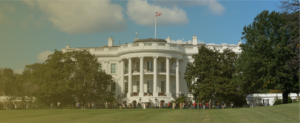
Photo credit: White House/Andrea Hanks
Aspiring presidents face a monumental task of preparing to govern. They must be ready to lead a federal workforce of about 2 million civilian employees,65 craft a budget of about $6.8 trillion66 and nominate or name about 4,000 appointees, about 1,200 of whom will require Senate confirmation. An effective presidential transition requires naming transition leaders early in the election year, establishing a clear set of priorities along with a robust workplan covering policy, federal agency review and a host of other issues. At the same time, career federal employees must prepare for an entirely new set of leaders.
The transfer of power also represents a vulnerable time for the nation because of a wide range of national security concerns, along with the need to deal with numerous pressing issues of the day, which in 2021 included the worst public health crisis in a century, economic turmoil and an extreme level of political divisiveness that resulted in challenges to the integrity of the election.
The 2020-21 transition continued the country’s tradition of a peaceful transfer of power, and President Biden was able to begin governing immediately upon taking office. But the Trump-to-Biden transition demonstrated that while the law prescribes many aspects of the presidential transition, key elements are governed by norms and good faith, and that these traditions alone are not enough to provide incoming administrations with the information it needs to be prepared to govern from Day One or guarantee a smooth transfer of power.
We must learn from the 2020-21 presidential transition and make the legislative and process changes highlighted in this report to avoid similar problems in the coming years.
Recommendations

Photo credit: Shutterstock
The following recommendations come from interviews and extensive study of the 2020-21 transition.
For Congress
Improving the Personnel Selection Process
- Congress should work with the White House and federal agencies to reduce the number of politically appointed positions that require Senate confirmation—and the number of appointees overall. This is the single change that will most dramatically improve the ability of new presidents to put their teams in place as quickly as possible. About 1,200 positions require Senate approval, and the large and growing number has contributed to the slowdown of the confirmation process and the increase in vacancies. The Partnership’s August 2021 report entitled, “Unconfirmed: Why reducing the number of Senate-confirmed positions can make the government more effective,” outlined this problem in detail.67
- The Senate should review and streamline its confirmation processes, including fixing the privileged nominations calendar to expedite noncontroversial nominations. The confirmation process has taken longer for each successive administration and has increasingly prevented presidents from putting their teams in place. The Partnership will work with the Senate to identify specific improvements.
- Congress should consider additional appropriations to support the surge in personnel and resources needed at agencies that experience increased workloads during transition years. This includes the FBI and other clearance-granting agencies for background investigations; the Office of Government Ethics for reviewing financial disclosures and conflicts of interest; and the Office of Presidential Personnel to expedite filling presidential appointments after the inauguration.
- Congress should consider providing additional appropriations to the General Services Administration for its support of the transition. Congress should ask the Government Accountability Office to determine the actual expenses required to support a transition in addition to the appropriations provided every four years by Congress, which in past transition cycles have included funding for presidential transition teams, GSA’s support of the outgoing administration and training of appointees. An examination of total expenses should include office space and IT support provided by GSA.
- Congress should expand the authority granted by the Intelligence Reform and Terrorism Prevention Act of 2004 by widening the range of a new administration’s appointees who are eligible for expedited background investigations and security clearances. These appointees should include those outside Cabinet departments and in presidentially appointed positions that do not require Senate confirmation.
- Congress should consider additional appropriations to support appointee orientation each year of an administration. New appointments take place throughout an administration and orientation support should be available throughout all four years of an administration. Appointees can be more successful with a strong orientation in government management and operations (such as ethics and budget processes), the laws that protect against conflicts of interest and political coercion, the need for transparency and accountability, and executive coaching and public service leadership.
Improving the Process for Post-election Activities
- Congress should reaffirm and clarify the Office of Management and Budget’s role as a service provider to transition teams given OMB’s “core of government” responsibility for government-wide planning and budgeting. OMB plays a central role in regulatory policy and rulemaking across all departments and agencies while its collaboration is important to facilitate an incoming administration’s development of a budget proposal. Treatment of OMB as a “service provider,” similar to OGE, FBI and NARA, would help incoming teams develop their agendas and prepare for governing.
- Congress should explore making fewer transition services dependent on ascertainment. For example, federal agencies and the White House should share information equitably with still-viable candidates soon after the election irrespective of ascertainment. This recommendation creates complexity because federal agencies must balance two responsibilities: to protect sensitive, nonpublic information and to prepare a viable president-elect to govern. However, this change could allow deliberations on ascertainment to proceed while mitigating the effects of a delay on transition teams and agencies.
- Congress should more actively engage in its valuable public education and oversight role, using its tools to raise awareness and support implementation of the Presidential Transition Act.
For the White House
- Incumbent presidents should identify priorities for a second term and assign a senior staff member within the White House to organize policy and personnel planning to transition to another four years.
- The incumbent president has a duty to the American public to uphold national security and the national interest. Part of that responsibility is to support a president-elect’s planning so that individual is prepared to govern. The Presidential Transition Act codifies this responsibility into law, but as outlined above, more can be done to strengthen this framework to ensure important transition norms and traditions are upheld.
- The White House and transition teams should cooperate closely on emerging national crises, threats and major events facing our nation. The federal transition coordinator should play a formal role in determining specific issues and data to be shared during the transition. Among several examples, the 2020 transition saw delays on data-sharing about vaccine distribution and other public health issues in large part due to the questions regarding what type of information provided by the Centers for Disease Control and Prevention could be shared with those outside government, including the Biden transition. Issues of such great importance—such as the housing market crash in 2008 and the pandemic in 2020—require particularly close cooperation.
- Consistent with the Presidential Transition Act, the White House should conduct emergency preparedness and tabletop exercises with participants from the incoming administration as matter of national security.
- The president’s budget request should incorporate full and necessary expenses for GSA support to transition teams every four years, as well as surge support for transition services agencies such as the Department of Justice, the National Archives and Records Administration, the Office of Government Ethics, the Office of Personnel Management and the Office of Presidential Personnel.
- The White House should take the lead in developing an appointment dashboard that shows what information and forms are needed at each step of the appointee process, and the status of completion of each step. This would keep the White House, agencies, transition teams and appointees apprised of uncompleted tasks and what is necessary for appointments to move forward. Such a tool would be useful throughout a president’s term, but should also be made available to transition teams. Agencies such as GSA and the U.S. Digital Service could help develop the dashboard, but a White House champion for such a project would be critical.
- The White House should lead the creation of a smart form to auto-populate appointee answers to questions when asked for the same or similar information. Forms for security clearances, financial disclosures and Senate committee questionnaires often ask similar questions, and nominees must enter the same information in multiple places. A smart form was endorsed by the bipartisan Working Group on Streamlining Paperwork for Executive Nominations created by Congress.68 As stressed by the working group, the efficiency of a smart form would depend on reducing duplicative or overlapping questions, such as those that ask for similar information but in a slightly different way. A smart form would speed the completion of vetting processes and reduce innocent mistakes that may slow an appointee’s progress.
For Federal Agencies
- Federal agencies should start planning for transition as early as practicable and no later than spring of an election year. The 2016 amendments to the Presidential Transition Act require agencies to designate a career executive to oversee transition planning in May of an election year, six months before a presidential election. Transition leaders who started even earlier felt they were better prepared to handle a wider range of scenarios than those who started later.
- The annual meetings of the Agency Transition Directors Council should be used to review lessons learned from previous transitions, document all of the steps and procedures they use for each transition cycle and prepare for future improvements. Since so much of agency preparation is based on precedent—and each is allowed flexibility regarding how it prepares—everything needs to be clearly documented and recorded to help in future transitions. The 2016 amendments to the Presidential Transition Act require the Agency Transition Directors Council to meet annually, even in nonelection years. Those meetings are a valuable prompt to continue documenting lessons learned and best practices in agency transitions.
- Briefing materials prepared by agency transition directors should be concise and focused on major issues facing incoming leaders. Materials should be accessible to both post-election transition teams as well as incoming agency leaders post-inauguration.
- As required by law, federal agency leaders should engage in responsible succession planning that identifies career officials to serve in critical roles in the event of a vacancy, and these succession plans should be shared with the transition teams. Agencies should also support these future acting officials with training, resources and support necessary for them to conduct the full scope of their responsibilities. Acting officials often remain in place for months, and some for years.
Ongoing Challenges
- The Department of Justice and the Office of Government Ethics should prepare in advance for a surge in personnel activity following an election to reduce potential bottlenecks in the ethics review and background investigation processes. All relevant agencies should be staffed to handle the peak volume of political appointments that occurs during transition years and throughout the first year of a new administration, including the high number of political appointments that require Senate confirmation.
- The Department of Justice should regularly join the meetings of the transition service providers including the General Service Administration, the Office of Government Ethics, the National Archives and Records Administration, and the Office of Personnel Management because of its important role in the background investigation process for transition staff and presidential appointees.
- The barriers to hiring and recruiting diverse applicants need to be identified and addressed. Some of these barriers include inconsistent use of suitability standards that deem someone eligible for a federal position; confusing financial disclosure requirements, and the often prohibitive cost of relocating to Washington, D.C.
- Agencies conducting background investigations should review standards for disqualifying behavior in light of state legalization of marijuana use during the past decade and, where appropriate, develop a government-wide standard. Some skilled individuals are deterred from applying or rejected for federal positions because of legal activities in their home states.
- The Department of Justice should consider consolidating its memoranda of understanding with transition teams to avoid potential delays in processing background investigations. Early in the transition process, GSA signs one MOU with each transition team that accounts for both the preelection and post-election phases. DOJ signs one MOU preelection and negotiates a second MOU after the election. Having a single agreement would expedite post-election support, particularly if an ascertainment delay occurs.
- The Agency Transition Directors Council should leverage the knowledge of experienced agencies to support agencies with new transition directors and personnel. Those agencies with a deeper bench of executives who have managed previous transitions could provide advice and support to officials new to the transition process.
- The Agency Transition Directors Council should work to identify one common video platform for interagency collaboration on the transition and for agency review teams to interview officials. All federal agencies rely on their own networks and tools. The lack of a common platform was a significant logistical challenge for the Biden team to communicate with agencies.
For Transition Teams
- Candidate transition planning should begin in spring of an election year. The Biden transition team began planning in earnest in March—about eight months before Election Day.
- Transition teams should define areas of responsibility and decision-making authority vis-a-vis the campaign at the outset of planning. The Biden transition team’s golden rule was that the transition should never distract from the campaign. Accordingly, the transition team decided it would defer to the campaign whenever there was a potential dispute.
- Transition teams must include a well-organized and staffed appointments team to screen resumes and vet applicants for presidentially appointed positions, devoting appropriate resources to both confirmed and nonconfirmed appointments. Personnel recommendations for the president-elect’s consideration are among the most important activities of a transition team.
- Transition teams should create fair and consistent compensation policies for salaried staff. In addition, transition teams should develop standards as to whether volunteers may receive pay or benefits from outside sources.
- Transition policy and agency review teams should be collaborative, not conduct their work in silos. For example, national security and domestic policy portfolios should be integrated with portfolios such as economic policy, technology and trade. Modern problems do not fall into traditional organizational boundaries and silos, and require cross-cutting policy development and assessment processes.
- If the president-elect intends to issue executive orders soon after taking office, the transition should prepare those orders executive orders during the transition so they can be quickly finalized and released by the White House. Personnel teams should prioritize quickly getting appointees in place who can implement priority initiatives.
- Agency review teams should incorporate personnel with relevant agency experience in the agencies they review. The Biden transition included many such officials in their agency review teams, which made the review and transfer process easier since those officials already had basic knowledge about the agencies, and many already had relationships with members of the career workforce. Team building among team members and future colleagues also eased the transition to governance.
- Transition teams need to fully prepare for the wind-down of the transition, which includes setting aside funds for this process. The Biden team acknowledged that “closing up shop” and complying with all necessary functions took longer than expected. This included the filing of tax forms for all relevant states, completing human resource and pay issues, offboarding employees and volunteers, and fulfilling all statutory requirements. Members of transition teams may be reluctant to devote time to this task while they are in the middle of transition planning, but doing so proactively will help make the final stages easier.
Ongoing Challenges
- To better shift from transition to governing, policy teams must establish better methods to develop and share materials created during the transition with future officeholders. For a range of reasons, not all material and content produced during the transition is shared with officials in government after the inauguration—some is pre-decisional or exploratory, some is sensitive and some is protected due to public records requirements at agencies. Transition policy teams should design their work processes and products to be shareable with future officeholders, keeping these potential barriers in mind.
- Future transitions will benefit from having remote work options, but must prepare for the related cybersecurity requirements and administrative challenges. Most participants agreed the remote transition made work more efficient and allowed for a more diverse staff. There was less need for travel time, experts could be involved regardless of geography, and many people appreciated added flexibility. At the same time, protecting information online becomes even more important, and it requires additional work to meet the state and local tax and other requirements to employ people around the country.
- Transition teams need to safeguard official emails and information, and train staff to safeguard personal communications. The individuals behind previous attempts to breach campaign officials’ emails in 2016 were interested in both personal communications and official campaign information. Regardless of whether future transition teams will utilize remote staff, the focus on secure systems and communications will continue to be paramount.
- Technology experts should be integrated with policy teams at a senior level to ensure implementation questions are addressed at an early stage. The Biden administration incorporated technology personnel into their transition policy teams to better assess how technology could affect and advance policy proposals and implementation.
- Transition teams need to plan for the increasing demand to vet candidates based on their social media and other digital activity. They should be prepared to develop their own standards around these new forums and dedicate necessary people, tools and technology to support these policies.
- Transition teams should connect with Senate committees as early as possible to understand committee-specific vetting and paperwork processes for future nominees. Each committee has unique rules, procedures and norms that affect how nominees are considered and whether a nomination will advance successfully to the full Senate for consideration.
- Presidents-elect should announce their intention to nominate their senior leaders, including Cabinet secretaries and top deputies, for the Senate’s approval on or soon after Inauguration Day. This should include the new administration’s national security team as recommended by the 9/11 Commission.
- Transition teams should fill a high number of presidential appointments that do not require Senate confirmation on Day One of an administration, including fully staffing the White House. The Biden transition team placed more than 1,100 appointees in government jobs on Inauguration Day by focusing on high-level appointments that do not require Senate confirmation. However, new administrations should be aware of the tradeoffs. These include the desire of many Senate-confirmed officials to choose their own teams when they finally arrive and the diversion of staff who could be used to vet individuals for Senate-confirmed positions.
- Transition teams should use the preelection period to assess which political appointments are a priority to fill based on the work that the president-elect most urgently wants to accomplish.
- Future transition teams should devote resources to planning for many different contingencies and scenarios. The contingency planning conducted by the Biden transition team was a major reason they were able to deal with the ascertainment delay and that the new administration was prepared to begin executing its agenda on Inauguration Day.
For Nongovernmental Organizations
- Nongovernment organizations should support a peaceful transition of power, including through public education, contingency planning and advocacy.
- More information and support should be available to prospective appointees, incoming political leaders and those nominated for Senate-confirmed positions. Despite efforts such as the Center’s Ready to Serve guide, questions still arise from prospective appointees and incoming officials about many critical steps required to secure a political appointment.69 Identifying and removing these barriers will help create more diverse and representative political leadership teams and can be an area where future transition teams collaborate with outside organizations.
- 1. Partnership for Public Service, “Ready to Govern: Improving the Presidential Transition,” Jan. 2010. Available at bit.ly/3AZ9T6Z
- 2. Partnership for Public Service’s Center for Presidential Transition, “Looking Back: The Center for Presidential Transition’s Pivotal Role in the 2020-21 Trump to Biden Transfer of Power,” April 2021. Available at bit.ly/3jadYzh
- 3. Partnership for Public Service’s Center for Presidential Transition, “Transition Lab: State of the Transition: An Update With Ken Burns, Josh Bolten and Eric Rauchway,” Nov. 23, 2020. Available at bit.ly/2WqV7qB
- 4. Martha Joynt Kumar, “Joseph Biden’s Effective Presidential Transition: ‘Started Early, Went Big,’” Presidential Studies Quarterly 51(3), Aug. 6, 2021. DOI: 10.1111/psq.12732. Available at bit.ly/2WX8hfk
- 5. Derrick Bryson Taylor, “A Timeline of the Coronavirus Pandemic,” The New York Times, March 17, 2021. Available at nyti.ms/3xyxtp7
- 6. Susan Heavy and Trevor Hunnicutt, “Biden leads observance of America's 400,000 COVID-19 dead on eve of inauguration,” Reuters, Jan. 19, 2021. Available at reut.rs/3Gj2emz
- 7. Dan Burns and Mark John, “COVID-19 shook, rattled and rolled the global economy in 2020,” Reuters, Dec. 31, 2020. Available at reut.rs/3f6JSKo
- 8. Michael Dimock and Richard Wike, “America is exceptional in the nature of its political divide,” Pew Research Center, Nov. 13, 2020. Available at pewrsr.ch/3fNCRi6
- 9. Emma Jones, “The Formal Transition Period Has Begun. What Happens Now?” Partnership for Public Service’s Center for Presidential Transition, Nov. 20, 2020. Available at bit.ly/376SVXC
- 10. The Office of Management and Budget, “A Letter to the Biden transition team,” Dec. 31, 2020. Available at bit.ly/3z4x6Ed
- 11. Lisa Friedman, “Trump Administration Is Planting Loyalists in Biden Transition Meetings,” The New York Times, Dec. 8, 2020. Available at nyti.ms/3kZwRWD
- 12. Tom Jackman, “Police union says 140 officers injured in Capitol riot,” The Washington Post, Jan. 27, 2021. Available at wapo.st/2TG6ytv
- 13. Bart Jansen, “130 officers have left Capitol Police since Jan. 6 insurrection, watchdog tells Senate hearing,” USA Today, Dec. 7, 2021. Available at bit.ly/3s3jbhc
- 14. Partnership for Public Service, “We’ve Done This Before: Presidential Transitions During a Time of Crisis,” Nov. 2020. Available at bit.ly/3bM9ha4
- 15. Partnership for Public Service, “Ready to Govern: Improving the Presidential Transition,” Jan. 2010. Available at bit.ly/3AZ9T6Z
- 16. Partnership for Public Service, “Ready to Govern: Improving the Presidential Transition,” Jan. 2010. Available at bit.ly/3AZ9T6Z
- 17. Benjamin Swasey and Elena Moore, “Bernie Sanders Endorses Joe Biden for President,” April 13, 2020, NPR.org. Available at n.pr/3iXdSK3
- 18. Partnership for Public Service’s Center for Presidential Transition, “Transition Lab: The Biden Transition to Power,” Dec. 18, 2020. Available at bit.ly/2WqV7qB
- 19. Partnership for Public Service’s Center for Presidential Transition, “Transition Lab: The Biden Transition to Power,” Dec. 18, 2020. Available at bit.ly/2WqV7qB
- 20. Alice Miranda Ollstein and Daniel Lippman, “How Biden aims to Covid-proof his administration,” Politico, Dec. 9, 2020. Available at politi.co/3jUeh1j
- 21. Mike Memoli, “Biden builds out his presidential transition operation,” June 20, 2020, NBC News. Available at nbcnews.to/3xbnxSn
- 22. Partnership for Public Service’s Center for Presidential Transition, “Transition Lab: Yohannes Abraham on Leading the Biden Transition,” Jan. 19, 2021. Available at bit.ly/2WqV7qB
- 23. Partnership for Public Service’s Center for Presidential Transition, “Transition Lab: Yohannes Abraham on Leading the Biden Transition,” Jan. 19, 2021. Available at bit.ly/2WqV7qB
- 24. Partnership for Public Service’s Center for Presidential Transition, “Transition Lab: Yohannes Abraham on Leading the Biden Transition,” Jan. 19, 2021. Available at bit.ly/2WqV7qB
- 25. Partnership for Public Service’s Center for Presidential Transition, “Transition Lab: Yohannes Abraham on Leading the Biden Transition,” Jan. 19, 2021. Available at bit.ly/2WqV7qB
- 26. Ted Kaufman, “I led the Biden presidential transition. Its leadership lessons can apply to any organization,” Fortune, May 4, 2021. Available at bit.ly/3oqsSo8
- 27. An analysis by the Center for Presidential Transition found that Biden announced 52 nominees for Senate-confirmed positions before his inauguration. This was greater than each of the previous three presidents, as Trump announced 29, Obama announced 42 and Bush announced 20. Biden submitted more nominees to the Senate on his first day than other recent presidents. He submitted 36 officials on his first day, compared with 13 for George W. Bush, 34 for Obama and 26 for Trump. However, only one nominee was confirmed on Biden’s first day, Director of National Intelligence Avril Haines. By contrast, seven were confirmed on each of Bush’s and Obama’s first days. Two were confirmed on Trump’s first day.
- 28. Alex Thompson and Tina Sfondeles, “West Wing Playbook: Joe Biden’s head of personnel is eyeing the exits,” Politico, July 26, 2021. Available at politi.co/3x8IAoA
- 29. Alex Thompson and Tina Sfondeles, “West Wing Playbook: Joe Biden’s head of personnel is eyeing the exits,” Politico, July 26, 2021. Available at politi.co/3x8IAoA
- 30. Martha Joynt Kumar, “Joseph Biden’s Effective Presidential Transition: ‘Started Early, Went Big,’” Presidential Studies Quarterly 51(3), Aug. 6, 2021. DOI: 10.1111/psq.12732. Available at bit.ly/2WX8hfk
- 31. Partnership for Public Service’s Center for Presidential Transition, “Transition Lab: Yohannes Abraham on Leading the Biden Transition,” Jan. 19, 2021. Available at bit.ly/2WqV7qB
- 32. Partnership for Public Service’s Center for Presidential Transition, “Transition Lab: Yohannes Abraham on Leading the Biden Transition,” Jan. 19, 2021. Available at bit.ly/2WqV7qB
- 33. Fortune Magazine, “I led the Biden presidential transition. Its leadership lessons can apply to any organization,” May 4, 2021. Available at bit.ly/3ip77B2
- 34. Paul Hitlin, “Senate Taking Longer to Confirm Biden’s Cabinet Than for Most Recent Presidents,” Partnership for Public Service’s Center for Presidential Transition, Jan. 28, 2021. Available at bit.ly/3C6HgGk
- 35. Michael D. Shear and Jim Tankersley, “Biden Denounces Storming of Capitol as a ‘Dark Moment’ in Nation’s History,” The New York Times, Jan. 6, 2021. Available at nyti.ms/2WdtmBW
- 36. Alice Miranda Ollstein, “Biden’s chief of staff has battled pandemics before. Here’s how he plans to beat this one,” Politico, Nov. 30, 2020. Available at politi.co/2WUuXx9
- 37. Alice Miranda Ollstein, “Biden’s chief of staff has battled pandemics before. Here’s how he plans to beat this one,” Politico, Nov. 30, 2020. Available at politi.co/2WUuXx9
- 38. Simon Lewis, “Biden COVID-19 task force says transition delay could be compromising U.S. virus response,” Reuters, Nov. 17, 2020. Available at reut.rs/3nsSuQP
- 39. Heidi Przybyla and Shannon Pettypiece, “In final transition days, Biden team gets access to critical COVID vaccine data,” NBC News, Jan. 14, 2021. Available at nbcnews.to/38OaHjd
- 40. Heidi Przybyla and Shannon Pettypiece, “In final transition days, Biden team gets access to critical COVID vaccine data,” NBC News, Jan. 14, 2021. Available at nbcnews.to/38OaHjd
- 41. National Archives, “Federal Register: 2021 Joseph R. Biden Jr. Executive Orders,” Aug. 2021. Available at bit.ly/3yy19mH
- 42. Fred Hiatt, “Opinion: The U.S. government is designed for failure. And, a new study shows, it’s getting worse.,” The Washington Post, Aug. 8, 2021. Available at wapo.st/3pDjjkm. Hiatt, who passed away on Dec. 6, 2021, was a strong advocate for reforming the Senate confirmation process.
- 43. United States Senate, “Nominations,” December 2021. Available at bit.ly/3lDPY8t
- 44. Congressional Research Service, “Submission of the President’s Budget in Transition Years,” RS20752, Jan. 28, 2021. Available at sgp.fas.org/crs/misc/RS20752.pdf
- 45. Niels Lesniewski, “Biden budget release faces extended delay,” Roll Call, Feb. 11, 2021. Available at bit.ly/3zVcjCI
- 46. Niels Lesniewski, “Budget process, COVID spending being undermined by OMB, Biden transition says,” Roll Call, Dec. 30, 2020. Available at bit.ly/3irP4Ku
- 47. Niels Lesniewski, “Budget process, COVID spending being undermined by OMB, Biden transition says,” Roll Call, Dec. 30, 2020. Available at bit.ly/3irP4Ku
- 48. Partnership for Public Service, “Samuel J. Heyman Service to America Medals: Mary D. Gibert.” Available at bit.ly/3uCLvWP
- 49. Partnership for Public Service’s Center for Presidential Transition, “Transition Lab: Preparing the government for a presidential transition,” Aug. 10, 2020. Available at bit.ly/2WqV7qB
- 50. “Presidential Transition Enhancement Act of 2019,” P.L. No: 116-121
- 51. Partnership for Public Service’s Center for Presidential Transition and Boston Consulting Group, “Transition Guide: A Comprehensive Guide to the Activities Required During Agency Transitions,” June 2020, p. 75. Available at bit.ly/30UJFpR
- 52. Partnership for Public Service’s Center for Presidential Transition, “Transition Lab: Chris Liddell on Trump’s Transition Out of Office,” Jan. 21, 2021. Available at bit.ly/3pOOk5l
- 53. Lisa Rein, Jonathan O'Connell, Carol D. Leonnig and Josh Dawsey, “As Democrats fume, the Trump appointee who can start the Biden transition is in no hurry,” The Washington Post, Nov. 20, 2020. Available at wapo.st/3gw7F7r
- 54. Philip Ewing, “Biden’s National Security Adviser: Pentagon Hasn’t Granted Meetings Since Dec. 18,” NPR.org, Dec. 29, 2020. Available at n.pr/3kdTG78
- 55. Jeff Zeleny and Ryan Browne, “Tensions intensify between Biden and Pentagon over stalled transition briefings,” CNN.com, Dec. 23, 2020. Available at cnn.it/385iuZe
- 56. Lisa Friedman, “Trump Administration Is Planting Loyalists in Biden Transition Meetings,” The New York Times, Dec. 8, 2020. Available at nyti.ms/3z8freR
- 57. Michael Stratford, “DeVos urges career staff to ‘be the resistance’ as Biden takes over,” Politico, Dec. 15, 2020. Available at politi.co/3AYxm8h
- 58. Partnership for Public Service’s Center for Presidential Transition, “Transition Lab: Chris Liddell on Trump’s Transition Out of Office,” Jan. 21, 2021. Available at bit.ly/2WqV7qB
- 59. Partnership for Public Service’s Center for Presidential Transition, “Transition Lab: Chris Liddell on Trump’s Transition Out of Office,” Jan. 21, 2021. Available at bit.ly/2WqV7qB
- 60. Partnership for Public Service’s Center for Presidential Transition, “Transition Lab: Preparing the government for a presidential transition,” Aug. 20, 2020. Available at bit.ly/2WqV7qB
- 61. Brian Naylor and Alana Wise, “President-Elect Biden to Begin Formal Transition Process After Agency OK,” NPR, Nov. 23, 2020. Available at n.pr/3xW49L2
- 62. Partnership for Public Service’s Center for Presidential Transition, “Transition Lab: Chris Liddell on Trump’s Transition Out of Office,” Jan. 21, 2021. Available at bit.ly/2WqV7qB
- 63. Franco Ordoñez, “Biden Can Receive Intelligence Briefings Now That Transition Is Underway,” NPR.org, Nov. 24, 2020. Available at n.pr/3mLreMU
- 64. Tamara Keith, “Biden’s COVID-19 Advisers Plead For ‘Ascertainment’ So They Can Plan for January,” NPR.org, Nov. 17, 2020. Available at n.pr/3gQvVkW
- 65. Congressional Research Service, “Federal Workforce Statistics Sources: OPM and OMB,” R43590, June 24, 2021. Available at bit.ly/3B4Af7W
- 66. Congressional Budget Office, “Budget.” Available at bit.ly/3D7b7xU
- 67. Partnership for Public Service’s Center for President Transition, “Unconfirmed: Why reducing the number of Senate-confirmed positions can make the government more effective,” Aug. 9, 2021. Available at bit.ly/3zC957V
- 68. Working Group on Streamlining Paperwork for Executive Nominations, “Streamlining paperwork for executive nominations,” November 2012. Available at bit.ly/3EAfrXJ
- 69. Partnership for Public Service’s Center for President Transition, “Ready to Serve.” Available at bit.ly/2WLTNis

